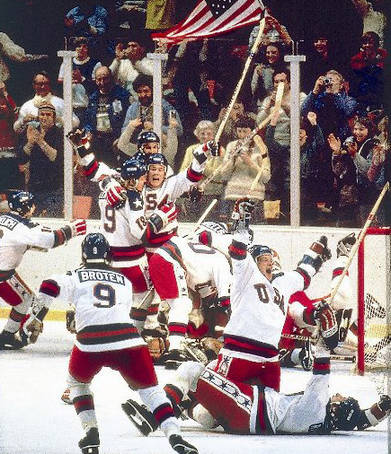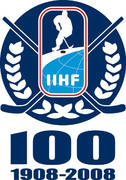Story #1
February 22, 1980 – Lake Placid, New York
The Olympic Fieldhouse in Lake Placid, New York, hardly seemed like the place where hockey history could be made, but on one afternoon in 1980, the greatest moment in international hockey took place. It was a moment that transformed the game in one country and, over time, around the world. It was a moment that came to define Olympic success. It was a moment that came to inspire dreams. After February 22, 1980, anything was possible.
If international hockey had become boring by 1980, it wasn’t because of a lack of skill or a drop in calibre of play around the world. It was simply because the Soviet Union had become so powerful at the amateur level that no other team could compete on a regular basis with it. Like a great dynasty such as the Montreal Canadiens in the late 1950s, the Soviets perfected a system and used it to create an international dynasty.
In their case, they put their finest players together and had them all play on the same club team. They practiced eleven months of the year and devoted themselves exclusively to hockey. They were in flawless physical condition. They practised as five-man units to ensure everyone on ice knew where every teammate was at all times. They studied their opponents.
The one thing the Soviets could not produce in their system, however, was the intangibles. They learned this lesson only too well in 1972 when they lost three straight games on home ice to conclude the Summit Series to Canada. And, they learned this again in 1980. That year, an average player who played for USA in 1964 and 1968 took over as coach of the USA Olympic hockey team. His name was Herb Brooks, and the players knew him from his reputation at the University of Minnesota, where he led the Golden Gophers to three NCAA championships in the 1970s.
Brooks didn’t make the amateur collegians believe they could win gold so much as he demanded they try their best. And then try harder. And when the players had given him every ounce of their energy, he demanded gallons more. By the time the 1980 Olympics began, the players were ready to give their best, and let fate decide what that would be.
The team’s first game, February 12, was absolutely crucial to the future success of this USA team. They tied the game with 27 seconds left in the third period and goalie Jim Craig on the bench for an extra attacker, and this 2-2 tie with Sweden, a medal contender, gave the Americans tremendous positive energy. Two days later, they hammered Czechoslovakia, 7-3, an even more impressive win given that the Czechoslovaks were seen as sure to win silver to the Soviets’ gold. Two days after that, the Americans beat Norway, 5-1, an expected result, really, and on February 18 they walked over Romania, 8-2, to remain unbeaten through four games. After a routine 4-2 win over West Germany, the Americans were ready to face the Soviets, a team that had crushed them 10-3 in an exhibition game in Madison Square Garden on February 9, 1980.
The game could not possibly be close. Played in the afternoon at the Fieldhouse, it wasn’t even broadcast live by ABC in the United States, such was the obvious mismatch. Two hours later, the hockey world changed forever, though. The Soviets drew first blood in the first thanks to Vladimir Krutov, but shockingly Buzz Schneider tied the game. Sergei Makarov put the Soviets ahead, and then one of the game’s turning points occurred. As time wound down in the first period, Dave Christian took a shot that Tretiak saved. He gave up a rebound, though, and Mark Johnson made no mistake, tying the game at 19:59.
Soviet coach Viktor Tikhonov was so incensed by Tretiak’s play that he replaced him for the second period with Vladimir Myshkin. Years later, Tikhonov, the most successful coach in international hockey, admitted this was the biggest mistake he ever made. Nevertheless, Alexander Maltsev scored the only goal of the second period to give the Soviets their third one-goal lead. More tellingly, however, despite being the better team by a wide margin, USA goalie Jim Craig played the game of his life and refused to allow a fourth Soviet score.
Johnson tied the game for the Americans at 8:39 of the third, and then the game changed for one final time. With the period exactly half over, Mike Eruzione let fire a snap shot from the slot that beat Myshkin to give the USA a 4-3 lead. The Soviets pressed but could not beat Craig for the tying goal. As the final ten seconds of the game were played, fans started the countdown. ABC’s play-by-play announcer Al Michaels picked up on the chant, culminating with the famous line, “Do you believe in miracles? Yes!” as the game ended.
Two days later, after beating Finland 4-2, the Americans had won Olympic gold.
The win didn’t change the landscape of the game right away. It was a shocking and unexpected victory, but more importantly, it inspired a generation of American kids to play the game. When USA won its next important international event, the 1996 World Cup of Hockey, almost every player on that team pointed to the Miracle on Ice game as their inspiration for wanting to play hockey.
In time, the win also assured the international community that America would be part of the top nations. In the 1976 Canada Cup, for instance, the roster was a who’s who of minor leaguers and collegians. Soon after 1980, that never happened again.
This game was and remains the greatest moment in international hockey because of its impact at the time and its continued impact over time. For 20 college players to defeat a team that trained year round and won virtually every game it played before and after truly is, in a sporting sense, a miracle. There is no other word for it.
That this miracle became something lasting and enduring makes it all the more significant. The greater miracle is that it took a nation with nothing more than a mild interest in the game and made it into a world powerhouse that can today beat any other great nation on any given day. There have been greater teams which have accomplished greater feats over greater periods of time in international hockey, but there is only one game, one team, one moment, that can truly be called a miracle. And nothing can outclass a miracle. Nothing.
As part of the IIHF's 100th anniversary celebrations, www.IIHF.com is featuring the 100 top international hockey stories from the past century (1908-2008). Starting now and continuing through the 2008 IIHF World Championships in Canada, we will bring you approximately three stories a week counting down from Number 100 to Number 11.
The Final Top 10 Countdown will be one of the highlights of the IIHF's Centennial Gala Evening in Quebec City on May 17, the day prior to the Gold Medal Game of the 2008 World Championship.
These are the criteria for inclusion on this list: First, the story has to have had a considerable influence on international hockey. Second, it has to have had either a major immediate impact or a long-lasting significance on the game. Third, although it doesn't necessarily have to be about top players, the story does have to pertain to the highest level of play, notably Olympics, World Championships, and the like. The story can be about a single moment — a goal, a great save, a referee's call — or about an historic event of longer duration — a game, series, tournament, or rule change.
|
 |
Click here for the 100 Top Stories
|










